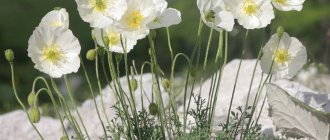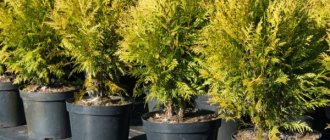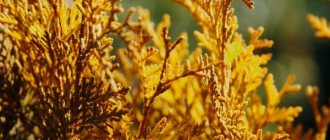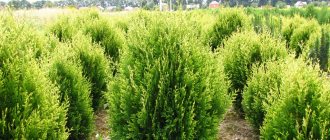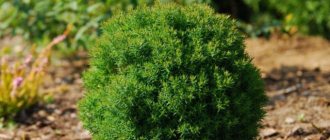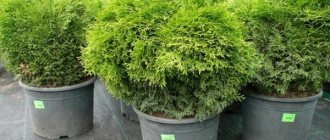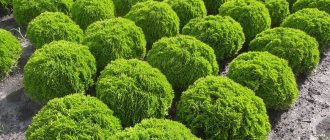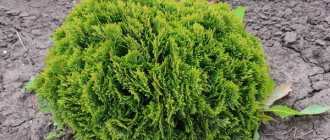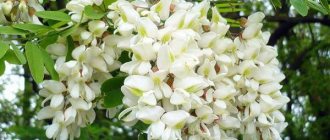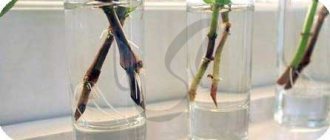Description of the plant
Thuja Aurea Nana is a dwarf evergreen shrub. The plant is a coniferous plant, very beautiful, miniature in size. Because of its size, many gardeners love to grow it around country houses and private houses. Once upon a time, thuja Aurea Nana could only be found in Beijing, but now, thanks to its beauty, it has spread throughout the world.
The plant received its second name - “tree of life” - for its very slow growth and longevity. It grows no more than 5 cm per year, and can live up to 1000 years.
This variety of thuja has distinctive features:
- The crown is very dense and has an oblong shape. Diameter - about 0.7 m.
- The branches are spreading, with a golden tint.
- In winter, this shrub is even more decorative: its crown becomes bronze.
- Fresh shoots come in two rows. After the third year, their shape becomes rounded and their color darkens.
- The height of the bush is usually about 1.5 m.
It is recommended to pay attention to one of the types of this thuja - Pyramidalis Aurea. It is used as a color accent in a landscape composition, as well as to create trimmed alleys and hedges.
Important! There are two varieties of the Aurea Nana variety: western and eastern. They are practically indistinguishable in appearance, while the western one grows in both sun and partial shade, while the eastern one feels good only in brightly lit areas.
Thuja orientalis Pyramidalis Aurea: features
The needles of Thuja pyramidalis are scaly, frequent, and even in winter they have an intense golden-yellow color.
The plant is resistant to short-term frosts not exceeding -25 degrees Celsius. Thuja orientalis biota tolerates drought well; in cold climates its growth slows down. The formation of cones on the oriental thuja Aurea Nana and other varieties of the oriental thuja begins in late August - early September. Pollination occurs in March-April, the following spring after fertilization, the female cones increase in size, and the seeds ripen in October. Both in natural conditions and in cultivated areas, Aurea Nana produces abundant and regular seeds.
Thuja orientalis (pictured) is a slow-growing species, which is ideal for those areas where there are no high-rise buildings - Pyramidalis aurea will not block the light and there is no need to worry about its frequent artificial shortening.
Application in landscape design
Aurea Nana is quite widely used in landscaping local areas. This is an excellent option for decorating a rocky garden or alpine hill, flower beds and mixborders. It can decorate the roof and terrace, as well as the balcony.
A hedge made up of these mini-bushes planted closely will be one of the most noticeable details in the selected area. Also, this species will look great in compositions with low trees and small bushes that have a striking relief shape of foliage.
Find out which plants can and cannot be planted next to the thuja.
Growing from seeds
For this method of propagation, seeds that were collected in the autumn are suitable. Seeds can be grown as seedlings in a box or directly planted in open ground. Substrate for coniferous plants is poured into the boxes and holes are made one centimeter into which one grain is planted. Afterwards, watering is carried out with settled water.
If the seeds are planted in open ground, they need to be loosened and fertilized in the required area. Then make shallow holes (no more than 2 centimeters) and plant a seed in each. Cover with soil, lightly compact the soil and water the area. When the first shoots appear, it is recommended to mulch the soil around them with sawdust.
Time and place for landing
Thuja is a light-loving plant, so it needs to be planted in a sunlit place, but without direct exposure of the plant to rays. A well-lit area, protected from drafts, with fertile, moist soil are the basic conditions that a young tree needs to form a complete root system.
If you plant a thuja in the shade, it will grow slower, its beautiful golden needles will turn green, and the crown will fade. The soil should be light and fresh, or rocky, as long as it is moist. Thuja loves the spring season, so it is better to plant it in early May.
Selection of seedlings
Planting thuja in a personal plot begins with the correct selection of seedlings. It is recommended to purchase them in specialized stores or nurseries whose owners breed this crop professionally.
For good rooting, it is preferable to buy young plants whose root system is closed. It is imperative to conduct a thorough inspection of the seedling and make sure that its ground part is not damaged and has no signs of disease, as evidenced by the healthy appearance of the needles and shoots, as well as their characteristic color.
When purchasing a plant in a container, make sure that the surface of the soil is clean (no signs of mold, unnatural inclusions, etc.) and moist. Saplings whose rhizomes are open should be carefully examined to ensure that the root shoots are intact, elastic and healthy.
We advise you to find out what is the difference between thuja and juniper.
Step-by-step landing instructions
Below is an algorithm of actions, following which you can plant thuja:
- Prepare the soil - a mixture of sand and peat must be poured into the hole.
- The hole should be about 80 cm deep; a layer of drainage should be poured onto the bottom.
- Before planting, it is worth holding the roots in water until the air comes out.
- Lower the seedling into the hole in the center, ensuring that the root collar is above the soil surface.
- Fill the hole with soil, not forgetting to compact the soil.
- After this, it is necessary to water using 15–20 liters of water.
- Finally, cover the surface with peat or pine bark.
Reproduction methods
The flatweed, also known as Platycladus orientalis, reproduces in three ways.
- Seeds. They are removed in the fall and stored under the snow or in the refrigerator until spring. This procedure accelerates seed germination. Planting is carried out from April to May in pre-made grooves.
- By cuttings. Two-year-old branches, which are pruned in early summer, are used as planting material. The sections are treated with drugs that stimulate growth and also prevent the development of diseases. After this, planting is done in a container to a depth of no more than 3 cm.
- Dividing the bush. If the thuja grows with two trunks, you can carefully divide it. The division should occur in such a way that each trunk has roots.
Further care
The miniature Aurea Nana, like all its tall fellow tribesmen, is a very hardy plant that is unpretentious to growing conditions. High-quality planting material will provide you with half the success when growing. It is better to plant in the spring in already warmed soil, so that the young animals have a whole season to settle in a new place. If these conditions are met, minimal care will be required: high-quality moderate watering, fertilizing 1-2 times per season and mulching.
Did you know? Native Americans used thuja needles as a cure for headaches and scurvy: its leaves and stems contain large amounts of vitamin C.
Watering and sprinkling
When deciding on a watering schedule, remember that all evergreens evaporate a lot of moisture and that is why they are so demanding of additional water supplies. An adult thuja of the variety in question easily tolerates short droughts, but previously requires regular, at least 2 times a week, watering. Moreover, it is necessary to moisten it through a sprayer, carrying out the action throughout the entire circle around the trunk. From the second season you can reduce the number of procedures to two per month.
Irrigation of the crown (thick spraying with clean water from a spray bottle) is also necessary for the young plant weekly. It is important to choose a moment when the sun is not at its peak in order to avoid burns to the pine needles.
On especially hot spring days during the sunshine, the crown of a young seedling must be protected by throwing any non-woven material or a special protective net. Once formed, in the absence of extreme heat, it is enough to water it twice a month.
Top dressing
In order to give the tree enough care without spoiling its decorative characteristics, it is important to follow the fertilizer application rate. Otherwise, the overfed thuja will begin to grow, and instead of fluffy greenery you will get bare shoots, and you will not be able to maintain the shape of the crown even with careful pruning.
Find out how thuja blooms.
Traditionally, fertilizing is done twice a year: in spring and autumn. But in exceptional cases, for example, on poor soils or after a plant has suffered a disease, one root application or even nutrient sprinkling can be added.
The nutrient mixture includes ash, beloved by dwarf thujas, and a specialized (intended for conifers) mineral complex. All fertilizers are applied to the soil through depressions in the root area.
In the spring, you can feed the slow-growing thuja Aurea Nana with nitroammophos, but not more than 25–30 g/m². It is recommended to apply potassium-containing mixtures in the fall.
Loosening and mulching
The basis for the vitality of any thuja is a strong root system. In order to limit excessive evaporation of moisture from the soil on the one hand and stagnation of rainwater on the other , it is imperative to regularly mulch the tree trunk circle. Using wood chips or pine needles, you will achieve good air exchange for the root system.
It is not worth stopping the procedure even for mature strong plants. Moreover, the market now offers materials that not only have a moisture-regulating function, but also have an attractive appearance. In addition, simple pine needles look interesting under a lush green cone.
Trimming
Graceful Aurea Nana is gaining popularity every year in personal gardens and city parks and recreation areas . Easy care, slow growth and visual attractiveness of the crown make this type of thuja an excellent material for creativity. But to maintain its shape, the plant requires competent and timely pruning.
First of all, this is sanitary pruning, freeing the crown from diseased and dried branches. Yellowed, insect- or frost-damaged parts of the tree are also removed.
Important! Thuja of the variety in question tolerates a decrease in temperature quite steadfastly. It also takes root well in urban environments and adapts to air pollution.
The second direction of cutting is aesthetic, shaping the silhouette of the plant , adjusting the density or lines of natural growth. Dwarf slow-growing thujas, which include Aurea Nana, rarely need such a designer haircut.
Regardless of the results you want to achieve, you need to trim thujas in spring or summer. If you hurry and start pruning in March, before the buds have formed, you can disrupt the growing season and stop the tree’s already leisurely growth. It is important to understand that any intervention is traumatic for the plant and will require further effort and time to recover.
Read what to do if bumps appear on the thuja.
Experienced gardeners agree that thujas can be trimmed no earlier than six years of age. This is exactly how long it takes for a plant to form a root system and begin to grow its crown evenly.
The three most serious mistakes can lead to injury or even death of the thuja:
- Too zealous removal of branches, more than 25-30% of the green mass of the crown. A plant that has suffered such a loss will simply not be able to provide itself with nutrition and moisture during a period that in itself requires additional strength to recover.
- Excessive exposure of branches, on which the thuja is not capable of restoring needles on its own - such shoots will simply dry out.
- Placing the cut close to the bud will lead to drying out and death.
Video: Pruning thuja
If sanitary pruning is mandatory, then decorative processing is a matter of taste. The lush hat with original pine needles is very attractive in itself.
Shelter for the winter
Preparation for winter is aimed at protecting the miniature plant from two serious dangers: low temperatures that are traumatic for the roots and snow masses that can damage the crown. Thujas tolerate the winter itself well, even with severe short-term frosts.
Did you know? The name “thuja” was first coined by the Swedish botanist Carl Linnaeus. In 1753, he described a ritual among the Greeks in which they used thuja to scent fire.
Moreover, during the snowy season, these evergreen shrubs become even more colorful, acquire an unusual bronze tone of the needles, and become a real decoration of the garden. But snow, especially wet snow, is dangerous for a tree of any age, and gardeners have to tape off the crown to protect the branches from breaking and the green mass from frostbite and rotting.
The root system itself, if it is already formed, does not need to be covered . And in the first years, spruce branches and any special covering materials are suitable for insulation. It is important to remember that, like all conifers, thujas are afraid of stagnant moisture and moisture, which will become fertile ground for fungal and other diseases. For this reason, it is important to choose a material that does not produce a greenhouse effect to protect the roots, and remove it in time - at the first sign of warming up of the soil.
Prevention of diseases and pests
Thuja Aurea Nana is distinguished by its endurance even against the backdrop of its extremely unpretentious relatives. And yet, some preventative measures will not be superfluous, especially since most thuja diseases manifest themselves against the background of stagnant moisture, and they can be avoided by observing the watering regime, choosing the right site and regular mulching. It is also important to avoid fertilizing with organic matter, especially chicken droppings and manure.
We recommend reading about the treatment of diseases and pest control of thuja.
There are preparations that have proven effective specifically for dwarf varieties: this is Bordeaux mixture (its recipe can be easily found in open sources) and fungicides, widely available on the market. The most important thing is to track the first signs of the disease in time: brown color of shoots, yellowing and falling of needles, ulcers and new growths on the bark.
Pests can also cause trouble, against which both insecticidal preparations and folk remedies are used. For example, most insects are afraid of infusions of dandelion and garlic. In any case, the branch damaged by insects, or the place where they have settled, must be destroyed. A tree that has been attacked by pests must be fed after disinfection.
Now you know how to grow a beautiful coniferous tree on your site that will delight you with its beauty all year round. Thuja Aurea Nana can be used in different forms and compositions, including as a hedge that will protect from strong winds. However, to do this, you should adhere to the rules and recommendations for care.
Species features
There are three main forms of flat branch: tall, dwarf and short. The first is used in creating hedges, in park alleys and garden groups. The second form is widespread in rock gardens and small garden plots. Low-growing varieties are often found in living borders.
The widespread use of thuja in landscape design is due to a number of reasons:
- Most varieties are unpretentious. They can grow on any soil, tolerate drought and do not need regular feeding;
- the compact fibrous root system ensures good survival rate for the plant even when transplanted in adulthood;
- A large number of varieties allows you to choose the best option for growing.
How to care?
Thuja orientalis is a rather unpretentious crop. In the first summer, young plants need frequent and abundant watering - at least twice a week, depending on weather conditions. In addition, in extreme heat, the bushes will be very grateful for spraying and sprinkling. Then you can reduce the frequency to once every 7–10 days, but in no case should you allow the soil in the tree trunk to dry out. Care consists of timely weeding, loosening the soil after each watering or rain and adding an additional layer of mulch.
The eastern variety, unlike the western one, has less frost resistance, so in late autumn, before the onset of cold weather, young plantings are covered. In this form, the thuja tolerates frost and strong winds well, but the bright spring sun can have a detrimental effect on it, causing burns on the bark and damaging the delicate needles. Therefore, in the spring you need to secure a light covering material in the form of an awning over the plantings. In spring, sanitary pruning is carried out, removing damaged and dried branches. This variety does not need shaping, as it itself forms an attractive crown in the form of a slightly elongated ball.
For better growth and development, it is useful to feed plants. In the spring, nitrogen-containing fertilizers are applied, during the summer those containing phosphorus will be useful, and, finally, in the fall - potassium ones. Thuja eastern "Aurea nana", like all other types of thuja, should under no circumstances be fed with humus, including manure. The tree may die from this.
